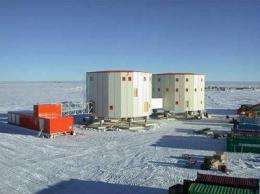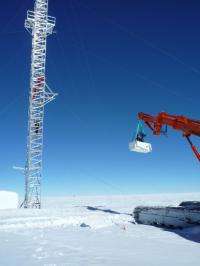Season's greetings from the other extreme

It is summer in Antarctica and the new crew for the Concordia research station will soon arrive. And since the place is second only to space for harsh conditions, they have been trained courtesy of ESA.
The Franco–Italian operated Concordia research base in Antarctica is a place of extremes, especially during the long, dark winter.
Now, during the summer, it is around –30°C and the Sun shines around the clock, but Antarctica will gradually show its other face starting from February.
Temperatures will drop to –80°C and, as the outpost sits atop a high ice plateau at 3200 meters, air pressure is a third less than at sea level – thin enough to threaten the crew’s health.
Venturing out requires not only warm clothing but also almost spacewalk procedures.
The environmental conditions are much like on the Red Planet, so the station is a light version of a Mars base. Two domes shelter 12 people against the forces of nature while they pursue scientific studies and test new technologies.
“I'm tired, worn out,” wrote ESA researcher Eoin Macdonald-Nethercott. He was a member of the last crew to over-winter at the site. Eoin lived and worked for more than a year at Concordia before coming home in December – later than planned because of several delays from adverse weather.
“Still happy though. I do like this place. Just like working in a hospital, the only currencies here are responsibilities and priorities.
“There are teams working side by side and sharing expertise whilst working toward their own diverse goals.

“And I find the people that come here are particularly friendly, perhaps sharing a camaraderie based on the feeling that it’s a special place to be.”
Team spirit in the middle of nowhere
After Eoin, the next ESA-funded crewmember for the coming winter is another Briton, Alexander Kumar. He will write a blog at esa.int/concordia starting in January.
ESA has been involved in the physiology, psychology and operational aspects of Concordia since its inception. In addition to being the base doctor, Alexander’s main task will be research.
Since 2006, ESA has offered ‘human behaviour and performance’ training for the crews, helping them to cope with the eight months of dark and cold.
The crewmembers are carefully selected and psychologically screened. They are totally isolated from March to October, dependent only on a satellite link and onsite resources.
“The new crew are mostly unaware of the effects of long isolation, lack of stimuli and confinement caused by the Antarctic winter,” says Loredana Bessone, astronaut trainer at ESA’s European Astronaut Centre in Cologne, Germany.
“It will take all of their efforts to remain a team throughout the winter, so our main task is to develop them into united and determined team.”
Adapted astronaut training
ESA’s approach is derived from the training provided for astronauts and flight control personnel.
“We go through the ‘forming, storming and norming’ phases, to get the team through a series of successes, reflect and act upon errors, and get ready to go through the same processes once the whole team meets again at Concordia at the beginning of the winter,” explains Loredana.
“Like astronauts, the crew is faced with running a base in extreme conditions, with very diverse goals and cross-cultural differences amongst team members.
“But these are also the keys to survival and success.”
Provided by European Space Agency



















